Dolphin FB and Officer's Quarters: Difference between revisions
Pbcjohnston (talk | contribs) Added photos and captions |
Pbcjohnston (talk | contribs) Finished photos for this section |
||
| Line 152: | Line 152: | ||
Further research has indicated that Dolphin had voice capabilities. | Further research has indicated that Dolphin had voice capabilities. | ||
<small>US Navy Photo Contributed by Roger Torgeson</small> | |||
[[File:Red bar sub new 2.jpg]] | |||
[[File:Dolphin Radio port-1.jpg|left|500px]] | |||
<div style="text-align: justify;"><span style="color:#00008B">The radio room looking outboard to port. Chairs are of a different type than seen in the wardroom. Between the chairs down almost at deck level we see another of the manual ballast tank flood valve handles. | |||
<small>US Navy Photo Contributed by Roger Torgeson</small> | |||
[[File:Red bar sub new 2.jpg]] | |||
[[File:Dolphin FWD BTY-1.jpg|left|500px]] | |||
<div style="text-align: justify;"><span style="color:#00008B">All of the photos above are the rooms and facilities above the deck in the forward battery compartment. Below the deck is one half of the boat's battery. This area contained 120 man-sized cells, all linked together. This view is looking forward. There was not enough space in the battery well for a man to stand up. He could only crawl along the wooden deck planks. Prior to entering the well the crewman removed all metal from his body to ensure he would not accidentally short a battery cell and get electrocuted. | |||
<small>US Navy Photo Contributed by Roger Torgeson</small> | |||
[[File:Red bar sub new 2.jpg]] | |||
[[File:Dolphin FWD BTY-2.jpg|left|500px]] | |||
<div style="text-align: justify;"><span style="color:#00008B">The forward battery well looking aft. This shows the arrangement of the battery cell ventilation system piping. When being charged, the cells would generate highly explosive hydrogen gas, which was vented overboard using this system. At the aft end of the space are the main battery disconnects that isolated the battery from the rest of the electrical bus. | |||
<small>US Navy Photo Contributed by Roger Torgeson</small> | |||
[[File:Red bar sub new 2.jpg]] | |||
[[File:Dolphin FWD BTY-2b.jpg|left|500px]] | |||
<div style="text-align: justify;"><span style="color:#00008B">A closeup of the forward battery disconnect switches. If open, these large and heavy switches would isolate the forward battery from the remainder of the electrical bus. | |||
<small>US Navy Photo Contributed by Roger Torgeson</small> | <small>US Navy Photo Contributed by Roger Torgeson</small> | ||
Revision as of 19:09, 14 June 2023
Forward Battery Compartment/Officer's Quarters/Radio Room
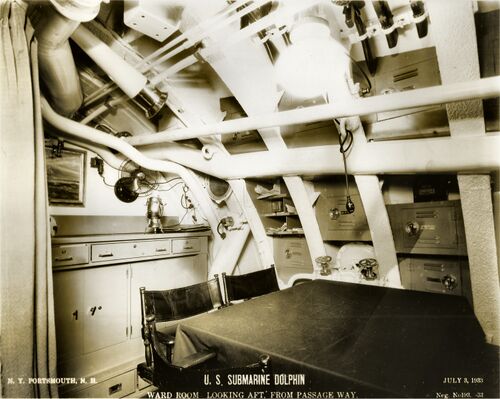
A counter is at the left that held dishes, linens and silver service such as serving bowls and platters and knives and forks. An electric coffee pot sits on the counter with a coffee cup on top that is turned up side down, in Navy parlance, meaning there is no coffee.
Stowed in the overhead are a number of rifles and sub machine guns. A storage unit on the hull has cubbies for each officer for his paperwork. The large rod just below the light fixture is the mechanical linkage for the bow planes.
US Navy Photo Contributed by Roger Torgeson
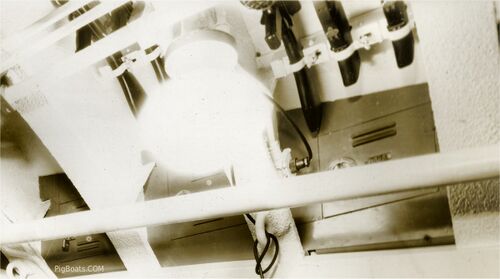
The large rod running left to right in the bottom of the photo is the mechanical linkage for the bow planes.
US Navy Photo Contributed by Roger Torgeson
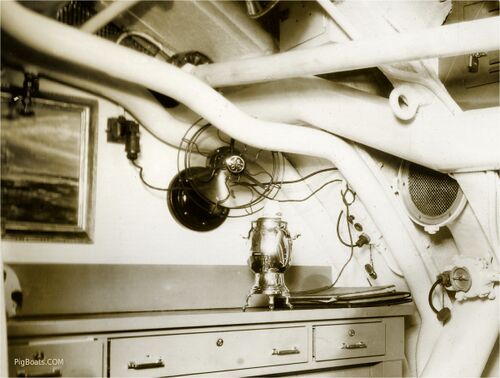
The large rod in the upper part of the photo is the mechanical linkage for the bow planes.
US Navy Photo Contributed by Roger Torgeson

The large rod in the top left of the photo and going through the bulkhead is the mechanical linkage for the bow planes.
US Navy Photo Contributed by Roger Torgeson
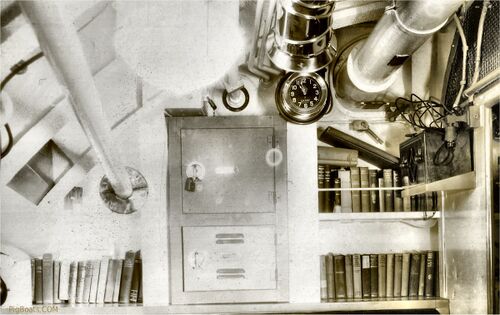
The Chelsea clock shows that this photo was taken at 10:58 in the morning on July 3, 1933. Chelsea Clocks are one of the most accurate marine clocks in the world.
The large rod seen at left in the overhead is the mechanical linkage from Control to the Bow Planes.
US Navy Photo Contributed by Roger Torgeson
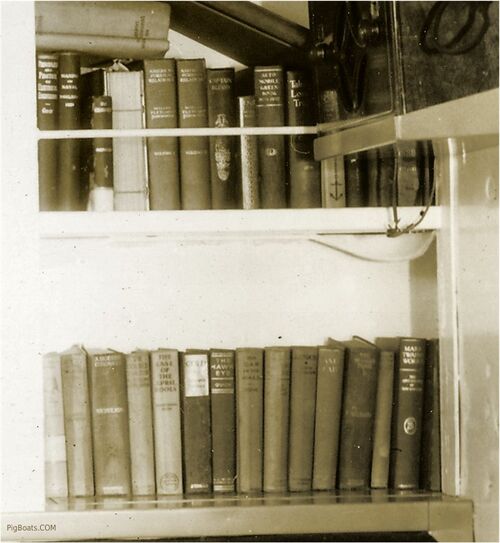
One of the titles is: "The Case of the April Fools" published in 1933 by Christopher Bush. Part of a mystery novel series. Another is: "The Ear in the Wall" by Arthur B. Reeve. The last one we can read the title of is "The Hawk(s) Eye" but we can find no information on it.
This is a good representation of the mixture of books taken to sea between the technical and recreational. Though the books are in the wardroom they are probably available to the whole crew.
US Navy Photo Contributed by Roger Torgeson

US Navy Photo Contributed by Roger Torgeson
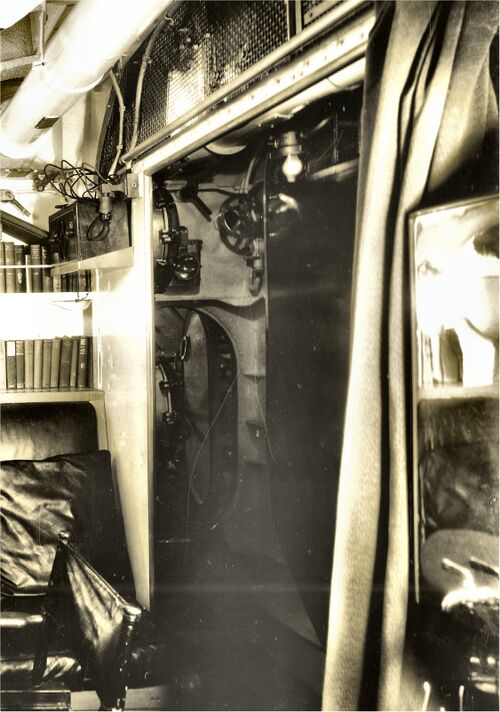
US Navy Photo Contributed by Roger Torgeson
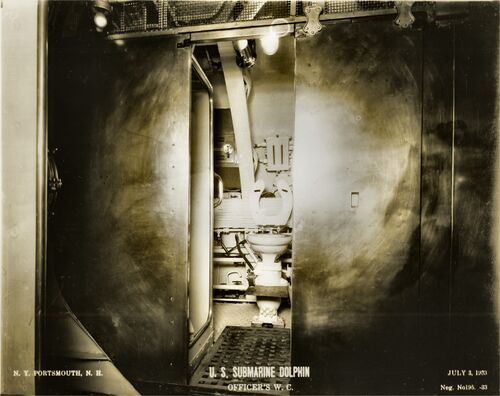
US Navy Photo Contributed by Roger Torgeson

US Navy Photo Contributed by Roger Torgeson
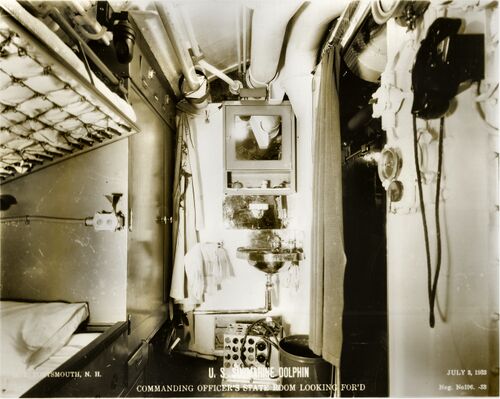
US Navy Photo Contributed by Roger Torgeson

US Navy Photo Contributed by Roger Torgeson

US Navy Photo Contributed by Roger Torgeson

US Navy Photo Contributed by Roger Torgeson
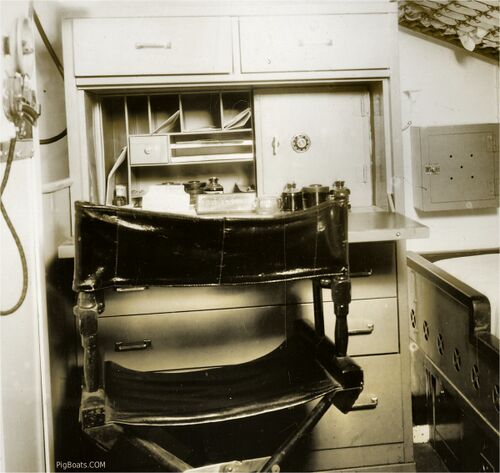
US Navy Photo Contributed by Roger Torgeson
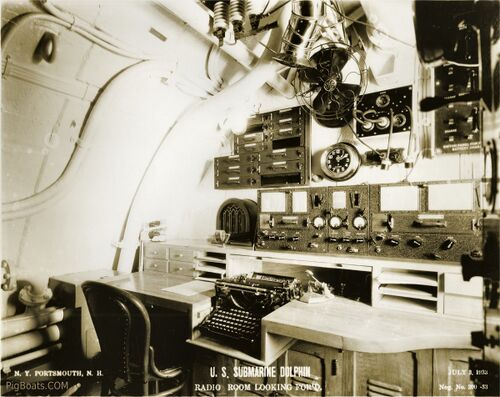
The following quotes are from Jon Krup who served in the Navy in early 1960's. He has these speculations on what we see here; "...the three pieces of equipment [above the desk] appear to be radio receivers.
Above them and to the left (above the loudspeaker), are what appear to be drawers. They are the necessary electronics to change frequency bands on the receivers. Pull one out and install in the radio and you are on the 10 MHz band. Another would put you on the 15 MHZ band, etc. The transmitters are out of the frame to the right. They appear to be either RCA, Collins or possibly Westinghouse receivers, more than likely Collins. Definitely tube type.
The drawers contained capacitors, coils (tuned circuits) and crystals specifically cut for a certain frequency band. There is in the upper right of the panels, a tuning dial - either a moving paper, or a rotating card, back lit, with multiple number scales, coordinated with the (I'm going to call them ) tuning drawers. Put in drawer #1 and use scale #1 to go with it, etc."
The rod seen to the left of the ceramic insulators at the top of the photo is the mechanical linkage for the bow planes.
US Navy Photo Contributed by Roger Torgeson

The following quotes are from Jon Krup who served in the Navy in early 1960's. "This is definitely the transmitter, more than likely specially designed for submarines. Note that it doesn't "go back into the wall very far.
I see no tuner dial on it, so I have to assume it is crystal controlled. There would be a small box containing crystals especially cut for the frequencies that submarines would use/be authorized to use. The radioman could change crystals depending on their location, time of day, and the atmospheric conditions. By atmospheric conditions, I don't mean weather, but what's happening up in the ionosphere. This could include the proximity of lightning, sun spots and the aurora. These frequencies would be set by the operational orders of that particular boat, and is coordinated with COMSUBLANT and COMSUBPAC.
The transmitter appears to be made by MCA, according to a plaque on the lower left corner, behind the chair. I can't quite make it out, but will, again, nose around the internet.
Note that they would only operate with Morse code. Voice transmissions were probably not permitted at that time, nor were they able with this transmitter. To talk ship to ship would be in Morse code until the boats got close enough to holler across the distance with megaphones."
Further research has indicated that Dolphin had voice capabilities.
US Navy Photo Contributed by Roger Torgeson
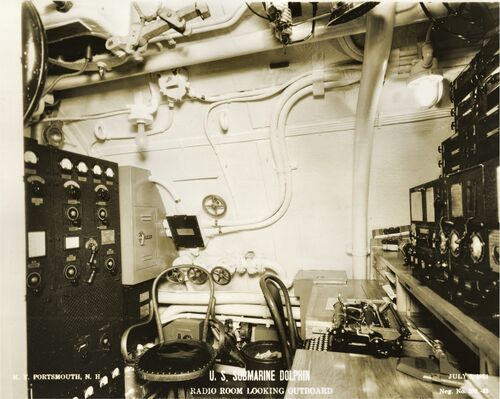
US Navy Photo Contributed by Roger Torgeson
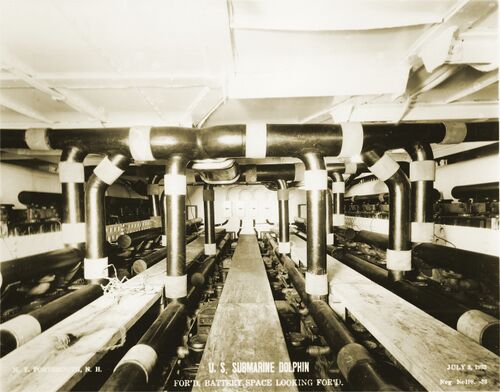
US Navy Photo Contributed by Roger Torgeson
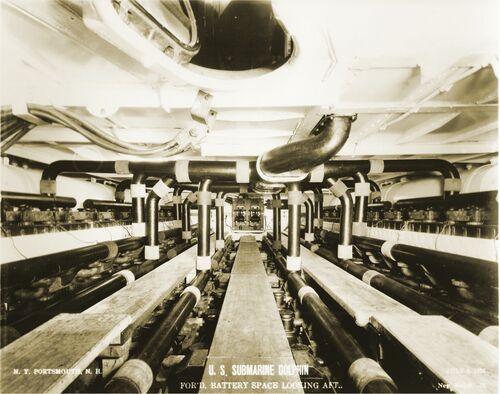
US Navy Photo Contributed by Roger Torgeson
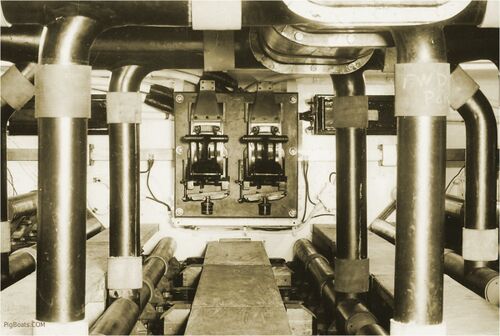
US Navy Photo Contributed by Roger Torgeson
Page created by:
Ric Hedman & David Johnston
1999 - 2023 - PigBoats.COM©
Mountlake Terrace, WA, Norfolk, VA
webmaster at pigboats dot com
